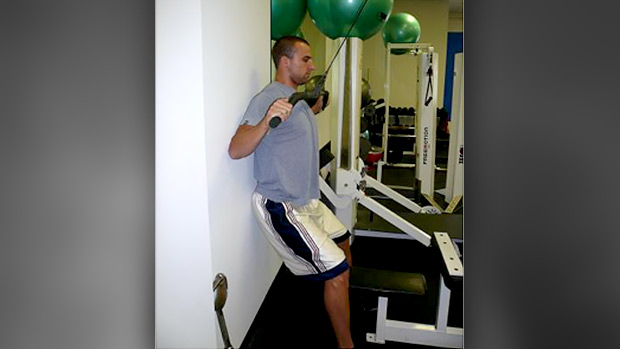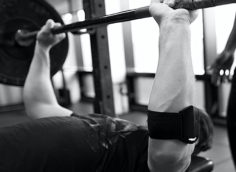Everyone knows the best lifts for building strength, size, and sport-specific power. But what if you can't squat because you have bum knees? What if you can't do bench presses and/or overhead lifts because of lingering shoulder injuries? What if your bad back makes deadlifts a bad idea?
I've worked with lots of athletes over the years with the issues I just described, and I've found alternative exercises that helped them get bigger and stronger. I'm able to do this with a concept I call joint-friendly lifting.
Joint-friendly lifts are simply creative variations that aren't as hard on the joints as their traditional counterparts. They allow serious lifters and athletes to work around their limitations without compromising the results they get from their training.
Before I get into the specific exercises, I want to wave the obligatory caution flag: Before switching out the tried-and-true lifts for the ones I show here, make sure the aches and pains you have aren't caused by suboptimal exercise technique, poor program design, or too much training with too little recovery.
I also want to mention an article I wrote a few months ago called "Making Gains with Pain." Today's article shows you how to work around your pain and limitations. The earlier piece shows you how to alleviate that pain. I know I'm biased, but I recommend it as a complement to the one you're about to read.
- The problem: back pain caused by disc issues prevents you from loading your spine with a barbell or dumbbells on traditional squats
- The solution: one-legged squat off a bench or step

The kettlebell folks have popularized the pistol squat (shown below). But I rarely use pistols with my athletes, especially those with back pain related to disc problems, since they force a lot of unnecessary spinal flexion. Also, pistols don't allow the glutes to activate as much as the variation shown above due to the position of the torso. Glute activation is important, since it helps reduce the load on the spine and increases stabilization of the knee joint.

The best way to add load to a one-legged squat is to put on a weight vest. This will increase the intensity of the exercise without adding stress to your bad back.
- The problem: back and/or knee pain
- The solution: sled work
I absolutely love sled training. I use it with just about everyone who walks through our doors. It's especially valuable for those who have knee problems and those who have back trouble. I've found these athletes can move heavy loads on the sled with no added stress on their painful areas.
Sled dragging
Sled dragging with the hand position shown in the photo below is much safer than using a waist or shoulder harness for people who have back issues. Be sure to maintain good spinal alignment, and don't allow your arms to move away from your sides.

Sled pulling

This is a great way to blast your quads if you have knee problems and can't do squats, lunges, or leg extensions. It's also a valuable exercise for knee rehab, thanks to the terminal knee-extension action it requires.
No sled? No problem – just get a big tire from a junkyard.
While I'm on the subject of tires, I should mention that tire flips, as performed in the example shown below, are not a joint-friendly lift. Even if you have the hip mobility to get low enough to maintain a neutral spine – an ability that eludes 90 percent of serious lifters, I'd estimate – this exercise still puts a serious amount of stress on your lower back.

I'm not saying tire flips are a bad exercise. But I am predicting that many of the people who do them will end up paying for some back surgeon's new Porsche. There are no bad exercises, just bad applications.
Sled/plate pushing
This is another of our go-to exercises for building strength and increasing work capacity without putting excess stress on the knees and backs of our athletes.
You want to keep your back straight, with your hips more or less level to your shoulders. Athletes with bad backs need to be especially cognizant of their back position, maintaining a neutral spine and avoiding spinal flexion as they step forward.

For building strength, stack up a sled and push it for 20 to 40 yards. To improve conditioning, use a plate push (as shown above) for 50 to 100 yards.
- The problem: disc herniation, or any other back injury that prevents you from doing deadlifts, hyperextensions, or reverse hypers.
- The solution: one-leg hip lift with weight plate
As with sled dragging, this is another exercise we use with almost everyone we train. But it's especially valuable for athletes and clients who need posterior-chain work but can't do the traditional hip-extension exercises.

Hold as much weight as you can without discomfort on top of your shin, as shown below.

The movement is straightforward. With the heel of your working leg on a bench or step, contract your glutes and hamstrings to elevate your hips off the floor, until your body forms a straight line from the knee of your working leg to your shoulders. Do all your reps with that leg, then switch.
- The problem: an injury that puts stress on the shoulder joint during press-type movements
- The solution: floor press
By limiting the range of motion, the floor press also limits stress on the injured shoulder. Many of our athletes who experience pain during and after bench presses find they can floor press big weights without discomfort.

- The problem: shoulder pain limits or prevents overhead lifts like the shoulder press and push jerk
- The solution: angled shoulder press
The reason it works for people who can't perform overhead lifts is simple: It's not overhead. It allows heavy loads and, as a bonus, requires the core muscles to control and resist rotation throughout the range of motion.

One key to performing the angled press is keeping your forearm perpendicular to the barbell, as shown below.

- The problem: shoulder pain prevents external shoulder rotation when the arms are overhead in exercises like the pull-up and lat pulldown
- The solution: angled lat pulldown
This is, as you probably guessed, the pulling version of the angled shoulder press. And like that exercise, it forces your core muscles to work as you struggle to stay upright as the weight pulls you forward. Execution is simple enough: stand in front of the lat-pulldown station and pull the bar to your upper chest.

You've heard this one hundreds of times: "Train smarter, not harder." In my opinion, the saying should be updated to this: "Train smarter and harder."
If you currently suffer from back, knee, and/or shoulder pain, you have no choice but to train smarter than the average lifter in your gym. But you also need to train harder to recover from your injury, and to prevent a recurrence. With joint-friendly lifts, it's possible to do both.
But even if you have no injuries, joint-friendly lifts are a pretty good way to help you maintain that winning streak. Not only are they easier on your most vulnerable joints, they provide new, interesting, and challenging ways to build muscle and improve your strength, athleticism, and work capacity.
Assuming, of course, you're interesting in that sort of thing...





